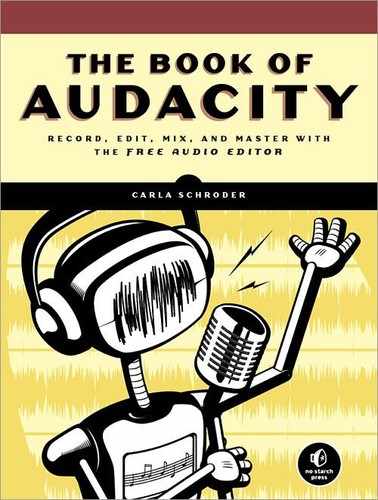Audacity is an open source, free-of-cost, cross-platform audio, recorder, editor, and mixer for Linux, Windows, and Mac OS X. It comes packaged in easy-to-use installers for Mac OS X and all versions of Windows, and Linux users will find it in the software repositories of their favorite Linux distributions. Visit http://audacity.sourceforge.net/ for downloads, documentation, and mailing lists.
In this book, we’ll be using Audacity 1.3.12 (and newer) on Ubuntu Studio and Microsoft Windows XP, Vista, and Windows 7. The stable 2.0 release will appear soon and should look very much like what you see in this book because the 1.3.xx series is the run-up to 2.x. This book is based on the very latest releases as they came out, so it is as current as any book can be. The 1.3.xx Audacity releases are considerably advanced from the old 1.2.x series. Every new release is full of wonderful improvements and bug fixes, so if you’re still using those old 1.2.x versions, you should consider upgrading.
Ubuntu Studio is Ubuntu with a huge set of multimedia applications. It is 100 percent Ubuntu-compatible, and it uses the standard Ubuntu software repositories. You can download Ubuntu Studio or simply add the Ubuntu Studio packages and artwork to any Ubuntu installation. There are several excellent multimedia Linux distributions, which you can read about in Chapter 13. You can use any Linux version you like; a few important system modifications you may need to make are covered in Chapter 13.
Windows requires some modifications too, which you’ll find in Chapter 14. Since Windows XP continues to hang on and refuses to enter retirement, you’ll find information for Windows XP, Vista, and Windows 7.
Audacity is fast and easy to use. What can you do with it? A whole lot:
Work with a wide number of different audio file formats and encodings, including WAV, AIFF, MP3, FLAC, AU, OKI, MAT4/5, Ogg Vorbis, WMA, M4A, and AC3.
Record live audio.
Convert legacy analog media to digital.
Make movie soundtracks.
Perform unlimited multichannel recording.
Edit and mix multiple tracks.
Overdub.
Use special effects of all kinds: wah-wah, change pitch and tempo, bass boost, echo, reverse, phaser, and more.
Add graceful fades, both in and out.
Normalize volume levels.
Fix defects such as hiss, static, pops, and hum.
Perform frequency analysis.
Write your own plug-ins for special effects.
Cut, copy, splice, and mix sounds together.
Audacity can open and edit audio files faster than most other audio applications and has nearly unlimited undo and redo.
So, what can’t you do with Audacity? Audacity does not support the RealAudio format, and it does not support MIDI. While it is wonderful for making mono and stereo recordings, it is not quite as good at making multichannel surround sound recordings.

